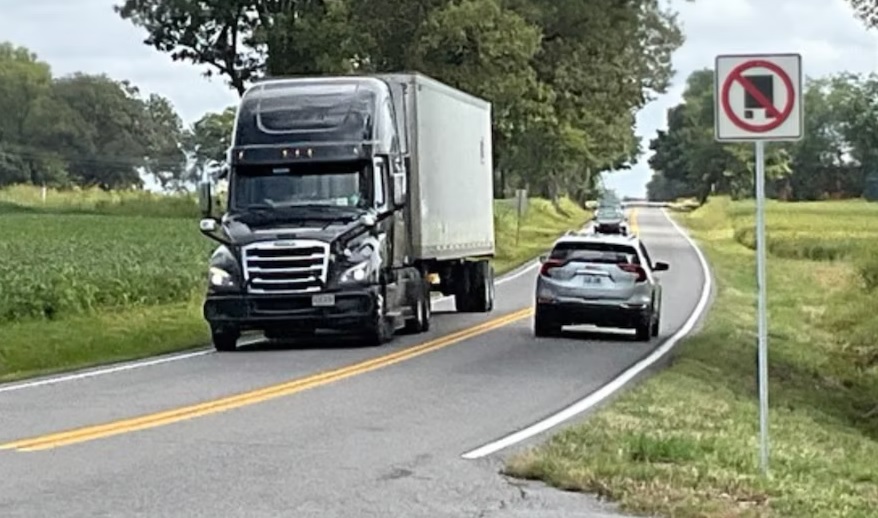Kentucky is taking steps to discourage big commercial trucks from using its rural roads as quick routes. The Kentucky Transportation Cabinet (KYTC) and the Kentucky State Police Division of Commercial Vehicle Enforcement are advising long-distance truck drivers to stick to designated routes that can accommodate the size and weight of their vehicles.
KYTC’s District 1 in Paducah and the Kentucky State Police Post 1 in Mayfield are intensifying their efforts to dissuade tractor-trailers from attempting to take shortcuts on rural secondary roads that were not designed for large long-distance trucks. They highlight that this is a widespread issue not only in Kentucky but also in neighboring states.
“This is a recurring issue as drivers try to save on time and fuel,” District 1 Chief District Engineer Kyle Poat said. “But our rural secondary roads were not built for regular through-travel by vehicles of such size and weight.”
According to a recent announcement by the transportation cabinet and state police, this issue is occurring on various roads throughout Kentucky, including KY Hwy 286, which spans southern Ballard County and serves as a shortcut between Wickliffe and Paducah. They disclosed that within the past three years, there have been 119 accidents, 40 of which resulted in injuries, and five fatalities along a little over 16 miles of KY 286.
Around 30 of these accidents involved semi-trucks or “STAA trucks,” referring to the Surface Transportation Assistance Act of 1982, which established a national network of highways and bridges suitable for large trucks. Of the most recent 24 accidents on KY 286, approximately half of them were linked to commercial trucks.
Signs that read “No Truck” have been placed at both entrances of KY 286 as well as at intersections with state highways. Additionally, officers from the Commercial Vehicle Enforcement (CVE) have increased their patrols and issued multiple citations.
During the court proceedings related to these cases, the judge voiced his concern about the necessity for signs clearly indicating the prohibition of trucks. In response to this concern, CVE Officer Mark Townsend reached out to the Kentucky Transportation Cabinet (KYTC) District 1 for assistance, resulting in the installation of the “No Truck” signs, as reported by the two agencies.
“The signs will help with enforcement efforts as additional cases come up in district court,” Townsend said. “The legal responsibility falls on the CDL-carrying professional driver. The driver is required to follow a route that keeps the truck on the National Truck Network.”
To circumvent the restricted segment of KY 286, long-distance truckers traveling between Wickliffe and Paducah should opt for U.S. 60 instead. It’s important to note that the “No Truck” signs and associated restrictions do not pertain to local farmers or trucks engaged in local deliveries along KY 286.
The prevalent use of GPS mapping applications designed for passenger vehicles on cell phones has also contributed to the problem of trucks mistakenly venturing onto inappropriate routes, as mentioned in the statement. These phone apps lack crucial features that can highlight low overpasses and identify narrow roads and other obstacles that commercial trucks should avoid.
As an example, Poat, a representative, pointed out that long-haul truck drivers who rely on passenger vehicle GPS apps are occasionally directed onto the U.S. 45 Ohio River “Brookport” Bridge. This bridge has specific weight, height, and vehicle width restrictions that prohibit the passage of commercial trucks.
Truck drivers who rely on cell phone mapping systems often encounter problems when they approach a low railroad overpass in Hickman County along KY 307, located to the north of KY 94, even though there are multiple warning signs in place. This issue becomes more critical when truckers resort to phone apps as they attempt to find alternative routes to bypass accidents that have blocked major roads.
Poat emphasizes that truckers can prevent difficulties for themselves and other road users by investing in a GPS unit or map app explicitly tailored to guide over-the-road trucks on the National Truck Network.
The Kentucky Transportation Cabinet (KYTC) is reaching out to several websites catering to long-haul truckers, urging them to help alert commercial drivers about the risks associated with relying on phone map apps that are not designed for semi-trucks. Additionally, the agency has provided a list of mapping systems and apps specifically created for commercial trucks to assist them in navigating safely.
That list includes:
- Trucker Tools (FREE): https://www.truckertools.com/carriers/trucker-tools-app/Smart Truck Route (FREE): https://www.smarttruckroute.com/ Trucker Path: https://truckerpath.com/
- MileOn: https://mileonapp.com/
- Truckmap: https://truckmap.com/
- TomTom GO Navigation (available truck-specific subscription). https://www.tomtom.com/en_us/navigation/mobile-apps/go-navigation-app/
- Hammer App: https://www.hammerapp.com/





